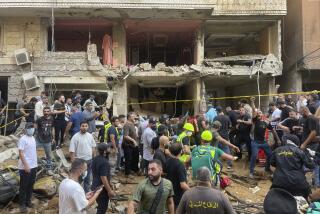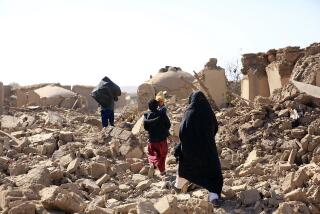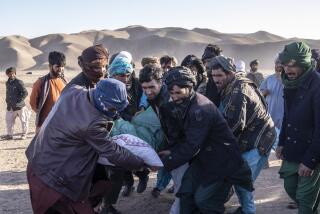Roadside bomb kills 14 civilians aboard minibus in Afghanistan
Reporting from Kabul, Afghanistan — Every day across Afghanistan, rural people crowd aboard rickety communal taxis that ply the roads linking remote towns and villages. And every day, they run the risk of what happened Thursday morning in Helmand province.
A roadside bomb ripped through a minibus in the Nahr-e-Saraj district of east-central Helmand, incinerating the vehicle and killing 14 people, including men, women and children.
The Taliban and other insurgent groups routinely seed roads that run through battle zones with explosives in hopes of killing and maiming Western troops — which the devices do, in large numbers. But more often the victims are Afghan civilians.
This has been the war’s deadliest year for noncombatants and combatants alike, with civilian casualties for the first 10 months of this year running 20% higher than the same period a year ago, according to the most recent figures available from the United Nations. Insurgents are blamed for more than three-quarters of civilian casualties, but Western troops inadvertently cause some as well.
Fourteen dead is an unusually high toll for a single roadside bomb, but not unheard of. Any form of inexpensive public transport is usually packed with whoever can squeeze aboard, and the consequences of hitting an explosive device reflect that overcrowding.
The number of wounded — four — was smaller because the blast was powerful enough to kill outright rather than injure. Over the last year, insurgents have planted larger and larger roadside bombs.
Daoud Ahmadi, a spokesman for the Helmand provincial government, said the explosion occurred on the highway to Kandahar, the south’s main urban hub in the neighboring province of the same name.
Together with Kandahar province, Helmand has been the scene of some of the year’s worst fighting. It started in the town of Marja, site of a U.S. Marine-led offensive that began in February and continued for months. In the autumn, the Marines took over from British troops in one of Helmand’s most violent districts, Sangin. The British suffered heavy casualties there; so have the Marines. Nahr-e-Saraj lies just to the south of Sangin.
Thursday’s bombing was condemned by Afghan President Hamid Karzai, who termed it “anti-human … brutal and ignorant.” NATO’s International Security Assistance Force, whose troops joined Afghan soldiers in aiding the injured, denounced the strike as well.
As the year wound down, battlefield deaths for both U.S. troops and the Western force as a whole stood at their highest levels of the 9-year-old war.
More than 700 NATO troops have been killed in 2010. Nearly 500 of those fatalities have been Americans, according to the independent website icasualties.org. U.S. troops make up about two-thirds of the 150,000-member North Atlantic Treaty Organization force.
More to Read
Sign up for Essential California
The most important California stories and recommendations in your inbox every morning.
You may occasionally receive promotional content from the Los Angeles Times.










